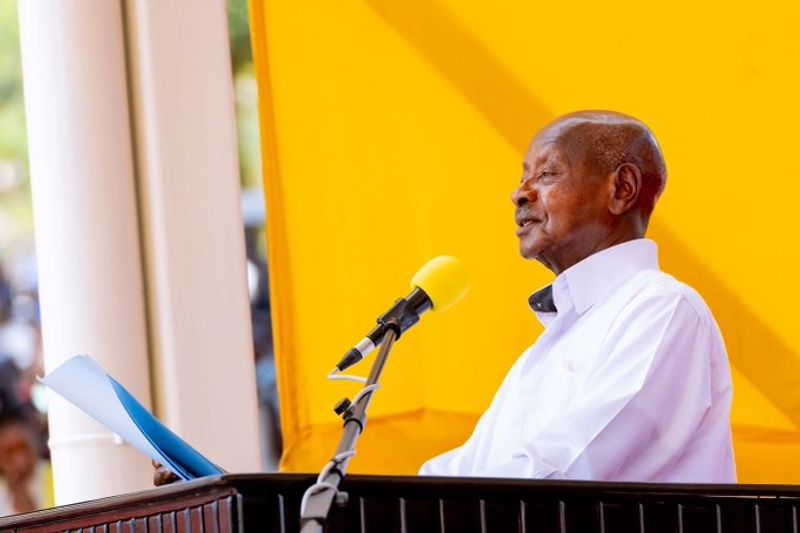
In a pivotal State of the Nation Address delivered today, President Yoweri Museveni drew a powerful analogy from the Gospel of St. Matthew, likening the National Resistance Movement (NRM) government to the wise builder who constructed his house upon a firm foundation. The President emphasised that this solid groundwork, built on the four ideological principles of Patriotism, Pan-Africanism, Socio-economic Transformation, and Democracy, has been instrumental in Uganda’s journey towards modernity.
President Museveni began his address by referencing Matthew 7:24-27, where Jesus speaks of two builders: one wise, who built on rock, and one foolish, who built on sand. He asserted that just as the wise builder’s house withstood the storms, the NRM’s governance has enabled Uganda to weather challenges due to its strong foundational principles.
“The National Resistance Movement can be likened to the wise man, in Jesus’ parable,” President Museveni stated, “because we have been able to establish the necessary foundation, to catapult Uganda to modernity, based on the four principles ideology: Patriotism, Pan-Africanism, Socio-economic Transformation and Democracy.”
The President underscored that the core aim of this ideology is to promote the “mass line,” ensuring the social upliftment of all segments of society, rather than just a select elite. He highlighted several flagship mass line programs that have driven significant improvements in the quality of life for Ugandans. These include Universal Primary Education (UPE) and Universal Secondary Education (USE), widespread mass immunisation campaigns, and various wealth creation initiatives such as Operation Wealth Creation, Emyooga, and the Parish Development Model.
Here is His Full Speech
STATE OF THE NATION ADDRESS BY
H.E. YOWERI KAGUTA MUSEVENI PRESIDENT OF THE REPUBLIC OF UGANDA
KOLOLO CEREMONIAL GROUNDS
5TH JUNE, 2025.
Her Excellency the Vice President;
Rt. Hon. Speaker of Parliament;
His Lordship the Chief Justice;
Rt. Hon. Deputy Speaker of Parliament; His Lordship the Deputy Chief Justice; Rt. Hon. Prime Minister;
Rt. Hon. Deputy Prime Ministers; Hon. Ministers;
Hon. Members of Parliament; Members of the Diplomatic Corps; Cultural and Religious Leaders; The Wana-inchi;
Distinguished Guests;
Ladies and Gentlemen.
In fulfilment of the Constitutional requirement, under Article 101 (1) of the Constitution of the Republic of
Uganda, I am here to deliver the State of the Nation Address, 2025.
Fellow Countrymen, Countrywomen and, especially, the Bazukulu, I applaud you all, for positively utilising the peace and tranquillity prevailing across the Country and the improved physical infrastructure to improve your personal lives, families and communities. Since the last State of the Nation Address, several people have departed from this earth. They include:
1. His Holiness the Late Pope Francis, the former Supreme Pontiff of the Catholic Church and Sovereign of the Vatican City;
2. The Late Hon. Major John Kazoora, the former Member of Parliament for Kashaari County;
3. The Late Hon. Sarah Mateke Nyirabashitsi, the former Minister of State for Defence;
4. The Late Hon. Muhammad Ssegirinya, the former Member of Parliament for Kawempe North Constituency;
5. The Late Hon. Dr. Yeko John Kissa, the former Member of Parliament for Kween County;
6. The Late Hon. Baba Diri Margaret, the former Woman Member of Parliament for Koboko District;
7. The Late Hon. Margaret Komuhangyi, the former Woman Member of Parliament for Nakasongola District;
8. The Late Hon. Besiisira Ignatius, the former Member of Parliament for Buyaga County East and Buyaga Constituency – Kibaale District;
9. The Late Hon. Frank Nabwiso, the former Member of Parliament for Kagoma County Constituency and many other Ugandans, who have succumbed to accidents, illnesses, etc.
I request that we rise up and observe a moment of silence in the memory of those who have passed on. May their souls rest in eternal peace.
The correct ideology of the NRM
In the Gospel of St. Matthew, chapter 7, verses 24-27, Jesus talked about two kinds of builders: the wise builder, who built his house on the rock; and the foolish builder, who built his house on the sand. When the rain, floods and wind came upon both houses, that of the foolish man was swept away, because its foundation was weak; while the one of the wise man remained standing, because its foundation was firm and strong.
The National Resistance Movement can be likened to the wise man, in Jesus’ parable, because we have been able to establish the necessary foundation, to catapult Uganda to modernity, based on the four principles ideology: Patriotism, Pan-Africanism, Socio-economic Transformation and Democracy. The aim of this ideology is to promote the mass line i.e. guaranteeing the social uplift of all segments of society; and not just the few elites.
The mass line programmes, such as UPE and USE, the mass immunisation campaigns, the wealth creation funds (e.g. Operation Wealth Creation, Emyooga, Parish Development Model, etc.,), have led to significant improvements in the quality of life, in Uganda. Life expectancy, in Uganda, is now 63 years, compared to 45 years, in 1986. This means that Ugandans are now living longer. In 1986, Uganda’s population was only 14 million people. The National Population and Housing Census, conducted last year, showed that Uganda’s population is now 46 million people. The literacy rate has also improved from 43% in 1986, to 80% now.
In 1986, more than 90% of the population was trapped in subsistence farming i.e. working only for food, with no surplus to take to the market to fetch money. There has been a significant reduction in the percentage of households in subsistence agriculture;
they are now 33%. These few illustrations show that, implementing the mass line programmes is the most effective way of triggering socio-economic transformation. Therefore, in line with the mass line philosophy of the NRM, we must prioritise the following:
1)Peace and security of persons and their property, in all parts of the Country;
2) Accelerating industrialization, with focus on building factories, which use locally available materials as inputs;
3)Export promotion and import substitution, by boosting the domestic manufacturing capacity;
4)Strengthening the private sector;
5)Increasing market access for our exports both in the regional markets, such as EAC, COMESA, among others and international markets;
6)Skilling our youth, through the Zonal Industrial Hubs. The youth will continue to acquire skills in tailoring, carpentry, metal fabrication, welding, shoe-making, weaving, hairdressing, knitting and bakery. We shall add plumbing and motor mechanics. The training is free of charge and no prior education qualifications are required;
7) Increasing revenue collection, by Uganda Revenue Authority, without hurting businesses;
8) Expenditure rationalization, by restructuring government.
9)Fighting corruption;
10) And ensuring that the remaining 33% of the homesteads, still practising subsistence agriculture, join the money economy.
Peace, security and regional stability
The general security situation, in the Country, is calm. However, the traditional and non-traditional threats to national security continue to manifest in the form of terrorism, negative political activism, general and cross-border crime, as well as health and environmental risks.
The national borders are secure, save for the spill over effects resulting from conflicts in the Eastern Democratic Republic of Congo, South Sudan, Sudan and Somalia. These include: influx of refugees and asylum seekers, illegal immigrants and proliferation of small arms and light weapons. The capacity of the National Security Agencies i.e. Uganda Police Force, Internal Security Organization, supported by the UPDF, has been enhanced in order to combat crimes and guarantee the safety of all Ugandans. The security situation in Karamoja Sub-region has significantly improved, despite pockets of criminality, in the form of livestock thefts and some incursions by the Pokot and Turkana from Kenya. Deployments to stop cattle thefts, by some Karimojong, in the neighbouring Sub-regions of Sebei, Teso, Lango and Acholi, have been maintained.
In the Eastern DRC, the joint FARDC-UPDF operations against ADF, are ongoing, with significant achievements. Since November, 2024, 223 abductees have been rescued from captivity, firearms with 992 assorted ammunition including:13 SMG, O3 RPG Bombs, 27 MGL Bombs, 01 Grenade, 1,020 rounds of PKM/SMG ammunitions, communication equipment,14 IED making materials and other bomb making materials have been recovered.
The government continues to modernise and professionalise Uganda’s security forces, by improving their welfare; and strengthening the cooperation between the civilian population and the security forces. The UPDF Construction Brigade has rehabilitated schools in rural communities and, together with the National Enterprises Corporation (NEC), has been involved in the rehabilitation of major infrastructure, such as Entebbe International Airport.
Political and economic resilience
It is paramount to jealously guard Uganda’s political and economic stability. All attempts to destabilise Uganda (by internal and external actors), have been thwarted and defeated. We welcome mutual and non- parasitic collaboration with everyone. Uganda’s priorities and interests are very clear; and, therefore, our allies must respect and uphold them, in all their dealings with us. The Patriotic leadership, in charge of the Country’s affairs, cannot deviate from its historical mission, to defend and transform Uganda and Africa, on account of threats, by some of our allies, who misunderstand our goals and methods of work. For instance, we are soon finalizing the construction of the 1,443km East African Crude Oil Pipeline (EACOP) from Buliisa to Tanga in Tanzania. The construction of the SGR, which I launched last year, is soon starting; and we have signed a Memorandum of Understanding with Alpha BMB Investment Group of the United Arab Emirates, to start the construction of the Oil Refinery in Hoima. Many other projects in roads, energy, ICT, schools, hospitals and agriculture, have continued to be implemented, despite the World Bank and the USA, suspending new financing to Uganda.
Our economy remains strong and resilient. It was recently ranked seventh, by the International Monetary Fund (IMF), among the fastest growing economies in the World. The size of the economy is projected at Shs. 224.9 trillion (equivalent to USD 60.4 billion), by the end of June, 2025. In 1986, the economy was only Shs. 42.6 billion or USD 3.92 billion. This means that, in dollar terms, the size of Uganda’s economy has expanded nearly 15 times, since the NRM government took power, in January, 1986. The economy grew by 6.7 percent in the first quarter of this financial year, compared to 5.6 percent recorded in the same period last year. This is on top of the growth of 6.1 percent, in the financial year 2023/24. Economic growth is projected at 6.3 percent, this financial year; and further projected to grow at 7.0 percent in the financial year 2025/26. It is projected to grow faster when commercial production of oil and gas starts, next year.
In Purchasing Power Parity (PPP) terms, our economy is projected to be USD 171.6 billion by the end of this financial year in June, 2025; and projected to expand further to Shs. 252.6 trillion next financial year (equivalent to about USD 65.7 billion using the Atlas Method). This will be equivalent to USD 187 billion, in Purchasing Power Parity (PPP) terms. This growth will translate into higher household incomes, from USD 1,259 income per capita, by the end of this financial year, to USD 1,330 as income per capita, next financial year.
In the past four years, our growth has been broad- based, inclusive and pro-poor. The latest National Household Survey Report, that was released recently, by the Uganda Bureau of Statistics (UBOS), shows that the share of Ugandans living below the national poverty line has fallen to 16% from 20% four years ago – surpassing the 2025 national target of 18.5%. With the continued implementation of the PDM, we are on track to completely wipe out poverty, in the near future. The same UBOS report revealed that income inequality has also declined significantly over the last four years. The gini-coefficient—a statistical measure used to determine the extent of income inequality within a population, has reduced to 38% from 41%, in 2020. In the 12 months to March, 2025, export receipts from merchandise trade increased by 26% to USD 9.3 billion. The Ugandan shilling is the most stable currency in the whole of Africa. During the past 12 months, it has appreciated by 6.1%. Inflation is under control. It is projected at 3.6%, in FY 2024/25; and Uganda has experienced Africa’s second lowest inflation rate, in the past decade.
Foreign Direct Investment (FDI) inflows are projected atUSD3.8billion,while tourism and remittance receip ts are projected at USD 1.5 billion and USD 1.4 billion respectively. During the next 5 years, it is projected that Uganda’s GDP is going to more than double, to USD 158 billion in 2030, in exchange rate terms and USD 296.9 billion, in Purchasing Power Parity (PPP) terms.
These achievements are not by accident. They are on account of deliberate and focused government interventions. Cumulatively, over the last ten years, the government has injected over Shs. 8.03 trillion, in strategic wealth creation initiatives, which have boosted economic performance. These initiatives include:
1. Capitalisation of Uganda Development Bank (Shs. 1.45 trillion), to provide affordable capital to manufacturers and small businesses;
2. Parish Development Model (Shs. 3.4 trillion by end of financial year 2024/25);
3. Emyooga (Shs. 553 billion);
4. Youth Livelihood Programme (Shs. 207.95 billion);
5. Small Business Recovery Fund (Shs. 100 billion); 6.Agricultural Credit Facility (Shs. 495 billion); 7.Youth Venture Capital Fund (Shs. 12.5 billion);
8. Uganda Women Entrepreneurship Programme (Shs. 168 billion);
9. INVITE Project (Shs. 800 billion);
10. GROW Project (Shs. 824 billion);
11. And Uganda Development Corporation (Shs. 1.2 trillion), among others.
Exports
Merchandise (goods) exports grew by 26 per cent to USD 9.3 billion in the year ending – March, 2025. The top exports include: gold (USD 3.788 billion), coffee (USD 1.837 billion), cocoa beans (USD 410.75 million), industrial products, such as cement (USD 335.30 million); metal products such as steel (USD 230.64 million), sugar (USD 190.28 million), fish (USD 177.69 million), etc. The export value of milk and milk products increased ten times, from USD 28.7 million, in 2015, to USD 285.4 million, in 2024.The total export earnings of goods and services, reached USD 11.81 billion by March, 2025.
Inflation
The prices of consumer goods and services have remained low, averaging 3.4 per cent, in the past 12 months to April, 2025. This is good for savers and investors, to be able to plan their investments. The low inflation was due to a stable exchange rate, good crop harvests; and the decreasing global prices of liquid fuels. The prices of diesel, petrol and kerosene reduced by 4.2 per cent, 2.5 per cent and 1.7 per cent, respectively, on average, for the year ending April 2025. The increased domestic capacity in sugar production has led to a reduction in consumer prices of sugar by 10.8 per cent, in April, from what it was in the same month a year ago.
The prices of beef have increased by 10 per cent, in part due to increased export of beef to the Middle East, which has increased demand. This is good for cattle keepers. The problem we still have is disease outbreaks, in some parts of the country, as well as cattle theft.
Government has, recently, vaccinated livestock, in most parts of the country; but, in some places, there is laxity in implementing the quarantines.
District leaders should always ensure that quarantines, especially against Foot and Mouth Disease, are strictly adhered to.
Foreign direct investment
As a result of the strong foundation that the NRM government has built over the years, Foreign Direct Investment (FDI), was USD 3.5 billion for 12 months to March, 2024. This was mainly in mining, transport, manufacturing, finance, etc. The single largest source of FDI was the Netherlands (55%), followed by France (20%), Kenya (6%), Tanzania (5%), UK (4%) and others (10%)
Domestic revenue mobilization
In 1986, the government collected only Shs. 5 billion, in revenue, because private businesses and manufacturing had collapsed. When the NRM took power, we embarked on the rehabilitation of the economy; and adopted the policies of liberalisation and reformation of the public institutions. As a result, the revenue collection capacity has improved. Revenue collection is projected at Shs. 31.9 trillion, this financial year ending June, 2025, equivalent to about 14.3 percent of total economic output (GDP). This is still less than the desired level to finance our development programmes. The government plans to collect Shs. 37.2 trillion, in domestic revenue, next financial year 2025/26. In order to boost revenue collection, the government will implement the following steps:
1.Enhancing efforts to fight corruption, at the URA, through regular audits, whistle-blowers and leveraging digital platforms, to minimize human interaction;
2. Minimising tax evasion using the Electronic Fiscal Receipting and Invoicing Solution (EFRIS), Digital Tax System (DTS) and Intrusive Scanners to improve real-time monitoring of taxable transactions, ensure accurate declaration of revenues and curb under-invoicing;
3. Combating Smuggling at border points through extended surveillance using advanced technologies like drones and tracking systems with increased patrols in high-risk areas;
4. Adopting specific tax duties to address under-declaration of values, particularly in manufacturing and imports of high-value goods;
5. Supporting Local Governments, including Municipalities, to increase revenue collection;
6. Recruitment and training of more tax officers at URA and other revenue-collecting institutions.
Economic diversification
Our economy is now more diversified and more sophisticated. In 1986, the economy depended only on the three (3) 3Cs, which are: Coffee, Cotton and Copper; and three (3) Ts, which are: Tobacco, Tea and Tourism. According to a study conducted by the Harvard Economic Growth Lab, in the last 10 years, Uganda added twenty (20) new products to its export basket and has an opportunity of harnessing production of 50 new complex products. Some of these new products include: ICT equipment, serums and vaccines, medicines, new pneumatic tyres, batteries, gas turbines, electronic integrated circuits, transmission apparatus for radio, telephone, television sets, measuring instruments for physical and chemical analysis, among others. These new products have contributed to the continued diversification of our exports.
Manufacturing
Manufacturing is the answer to the challenge of unemployment. Uganda has the raw materials and human resource, that can support factories specialising in the manufacture of automobiles, electronics, steel, textiles, furniture, food products, pharmaceuticals, aluminium products, etc. Some of the new products, which are manufactured here; and contributing to our export earnings include:
i. An electronics manufacturing plant, in Namanve Industrial Park, producing 120,000 hairdryers and 60,000 refrigeration parts per year;
ii.Pharmaceutical companies, producing four (4) million single HIV pills and 2 million other medicines per year;
iii.Dairy farms which produce 5.3 billion litres of milk and processing plants such as Royal Milk Enterprises, Jesa Farm, Brookside Dairy, Amos Dairies, Lakeside Dairies, GBK Dairy, Pearl Dairy, etc., process about 800 million litres of milk and 3,650 metric tons of cheese per year;
iv.Cut flowers worth USD 120 million being exported to Europe and other countries per year;
v.2,000 tons of avocados and 4,000 tons of bananas being exported to countries like South Sudan, Kuwait, Thailand and South Korea per year.
vi.Electronics, pharmaceuticals and solar energy products worth USD 60 million being exported to regional and international markets per year.
Therefore, with the roads and electricity we have now, the emphasis on skills development and the entrepreneurial spirit of Ugandans, the country can increase the share of manufactured goods, in total economic output, to the levels of South Korea, Thailand or Malaysia. In Uganda’s case, this is currently valued at USD 8.0 billion. It was only USD 237.3 million in 1986.
Investment
The return on private investment in Uganda is high. It averages 14 per cent per year (and can be higher in some sectors) compared to an average of only 5.2 per cent, in Europe in 2022.
If you invest in Uganda, you get back your initial investment capital in about 5 to 7 years; and the rest is profit, which our laws allow to repatriate without restrictions.
Increasing the size of the economy tenfold Government has put in place a strategy to increase the size of the economy to USD 500 billion by 2040. This strategy identifies four (4) anchor sectors. These are:
- Agro-industrialization;
2. Tourism development;
3. Mineral development, including oil &gas;
4. And Science, Technology and Innovation (STI) i.e. taking advantage of the knowledge economy, by prioritising investment in research development.
Agriculture production and agro-industrialisation
Government has invested in irrigation in order to boost agricultural production. This is because the provision of water for irrigation reduces the likelihood of crop failure, on account of water scarcity. Although Uganda’s irrigation area has increased from 22,976 hectares to 23,141 hectares, the country, however, has an irrigation potential of 3.03 million hectares. In order to achieve this goal, government is accelerating the construction of solar powered irrigation schemes, medium scale irrigationschemes, earth dams, communal and individual valley tanks and large scale irrigation schemes, across the country.
The construction works for ninety two (92) solar powered irrigation schemes, have been completed, adding an irrigation area of 900 acres. These are in the districts of: Apac, Buhweju, Buikwe, Bukomansimbi, Buliisa, Bushenyi, Butambala, Buvuma, Gomba, Hoima, Isingiro, Kakumiro, etc. The new solar powered irrigation schemes have benefited 111,600 farmers; and production yield from 112 schemes has increased to 3,600 tons, per season. The major crop enterprises in these irrigation schemes include: green pepper, onions, Irish potatoes, watermelons, tomatoes, apples, cabbages, pineapples, coffee, egg plants, vanilla, grapes, mangoes and pumpkins.
Construction works are also ongoing for twenty-two (22) solar-powered irrigation demonstration sites in the districts of Kabarole, Kyenjojo, Kole, Gulu, Napak, Abim, etc.
In Nakaseke district, the construction works for Kirema Phase I, a medium scale irrigation scheme, have been completed. Thus, adding a total of 124 hectares and benefiting 50 farmers engaged in growing coffee, passion fruits, maize and bananas.
The construction works for Wadelai irrigation scheme (1,000 hectares), in Pakwach district stand at 93.5%; the construction works for Namaitsu medium scale irrigation scheme, in Bududa District, are at 70%; Kawumu irrigation scheme is at 90%, among others. A mega irrigation scheme, Nyimur covering 3,300 hectares, has been constructed, in Lamwo district.
Other construction works include: Acomai irrigation scheme, in Bukedea District, covering 1,480 hectares and targeting 1,600 households; Atari irrigation scheme, in Kween/BulambuliDistricts, covering 680 hectares, targeting 2,667 households; and Namatala irrigation scheme, in Budaka/ Mbale/ Butaleja Districts, covering 3,450 hectares, targeting 4,923 households.
Performance of selected enterprises Dairy
The current production of milk stands at 5.4 billion litres as at end of 2024, compared to the 2.5 billion litres in FY 2017/18. We have also identified and secured foreign markets through government to governmentinterventions, e.g. Algeria, Nigeria. This has resulted into an increase in the value of milk and milk products from USD 28.7 million, in the FY 2014/15 to USD 285.4 million in the 2024. A new processing factory, Benni foods, has been commissioned and is currently operational with an installed capacity of 10,000 litres of milk per day.
Fish
The total value of fish catches from all the water bodies has also steadily increased since government deployed armed forces to assist in fisheries enforcement activities. Currently, we are producing 658,000 MT of fish annually. The availability of raw material (fish) sustained operations of the 12fish processing factories. The performance has also been a result of the government focus on gazetting of fish breeding grounds, enforcement of fisheries laws and regulations, provision of quality fingerlings and fish feed and providing an enabling environment for private sector to invest in aquaculture.
The value of fish and fish products exported increased from USD 148.7 million in FY 2020/21 to USD 152.8 million in the FY 2023/24.
Coffee
The volume of Coffee produced has steadily increased from 7.8 million (60 kg bags) in FY2022/23 to 8.2 million (60 kg bags) in the FY 2023/24. The performance in the coffee sub-sector is attributed to Government strategic interventions including: generation and distribution of improved coffee variety seedlings, supporting increased use of water for irrigation and promotion of use of fertilizers use among farmers. The value of coffee exports has steadily increased from USD 845 million in FY 2022/23 to USD 1,144 million in the FY 2023/24.
Government has provided NACCRI coffee research with a funding of UGX 30billion for the FY 2025/26, geared towards the development of improved coffee production, multiplication and disease, pest, climate resilient varieties.
Maize
The volume of maize increased from 3.4 million MT in 2018 to 5 million MT in 2024. Subsequently, the value of maize exports increased from USD 63.5 million in the FY 2018/19 to USD 195.3 million in the FY 2023/24. The performance is attributed to the increased adoption of improved maize varieties by farmers, increased value addition by private sector and increased vigilance by the government in control of pests and diseases.
Next financial year, the government will prioritise the following to support agro-industrialisation:
1. Appropriate agro-processing and value addition technologies;
2. High-quality agricultural inputs;
3. Construction of key water storage and irrigation infrastructure;
4. Enforcement of standards and market access;
5. Establishing appropriate post-harvest handling and storage facilities and infrastructure;
6. Disease, pest and vector control;
7. Supporting vertical and horizontal value addition for production of high-value multi-input products, such as nutritional foods, baby foods that use several products, like milk, eggs, maize, vegetables, fruits, etc.;
8. Extension services;
9. Investment in fertiliser production;
10. Certification and regulation of agricultural inputs and provision of appropriate finance for the various components of the agricultural value chain, among others.
The government has introduced the Large-Scale Commercial Farmer interest free credit facility of Shs. 175 billion. The money is accessed through Government owned Commercial Banks, that is: Post Bank, Housing Finance Bank and Pride Bank Limited. This enables large scale farmers to access mechanisation, in order to boost agriculture-based exports.
Parish Development Model
The Parish Development Model is now in its 3rd year of implementation. By the end of this financial year in June, 2025, Shs. 3.3 trillion will have been provided for PDM. The government is currently providing Shs. 100 million for each parish per annum. During my upcountry tours, I have interacted with some of the beneficiaries of the PDM funds, who have used them to start enterprises, in food crops farming, goat keeping, piggery, bee keeping, etc. In Kisoro, some of the PDM beneficiaries earned between Shs. 16-20 million, from onions over a period of two (2) years, using the initial seed capital of Shs. 1.0 million.
Tourism development
Tourism receipts were valued at USD 1.473 billion, in calendar year 2024. This is a significant recovery from USD 562 million in 2020, when we had a Covid-19 shutdown. The good performance is attributed to the sustainable peace and security, increased competitiveness of Uganda’s tourism industry, through marketing and Government investment in strategic tourism infrastructure.
To support tourism, the government has provided adequate security to the tourism sites, improved the physical infrastructure; and supported the tourist companies with tax relief. Government is strengthening Economic and Commercial Diplomacy (ECD), through our Embassies or Missions abroad, to promote tourism, in addition to mobilizing Foreign Direct Investment (FDI) and enabling penetration into export markets.
Uganda’s proactive support for Meetings, Innovations, Conferences and Exhibitions (MICE) and our participation in global tourism expos, resulted in hosting 267,623 tourists in wildlife protected areas. Government has maintained 1,202.3 kilometers of trail tracks and roads in these protected areas. An important aspect in tourism promotion is adherence to international standards in terms of grading of accommodation facilities such as hotels and restaurants, hygiene and sanitation facilities and access to cheap and stable communication facilities and the internet. In this regard, the government is upgrading the internet gateways to reduce the internet costs and increase the speed of internet connections.
The priority areas for tourism development next financial year 2025/26 and in the medium term include:
- Branding and marketing of Uganda as a tourism and investment destination;
2. Infrastructure development and construction of sanitation infrastructure in tourism sites;
3. Construction of refreshment centres and highway/road signage and sanitary facilities;
4. Improving tourism security;
5. Improving hospitality standards and training.
Mineral development
Uganda has a number of mineral resources, in almost all parts of the country. These include: oil and gas reserves, Beryl, Chromite, Lead, Lithium, Silver, Zinc, Kyanite, Feldspar and Diatomite, Manganese, Diamond, Uranium, Iron Ore, Vermiculite, Limestone and Marble, Gold, Graphite, Aluminous clay rich in Rare Earth Elements (REE), Phosphate and Iron Ore in Muko, from which we can make high quality steel and Sand. From these resources, Uganda has the opportunity to industrialize quickly, with acquisition of technology and specialised skills development, which is tailored to industrialization.
Until recently, when we started refining gold, our minerals were being exported in raw form. This means we were donating all the benefits, such as jobs and money, to other countries. Government has stopped the export of unprocessed minerals. In Tororo, where we have large deposits of Limestone; and Kabale, where we have iron ore, the government has facilitated the use of these minerals for making cement and steel, respectively.
In Kabale, we have put in place the infrastructure for mining the iron ore, from which domestic steel manufacturers have started making high quality steel.
There are ten (10) gold refineries in the country, producing gold which is refined to 99.9 per cent purity. There are gold mining activities in Busia, by a Chinese company, called Wagagai and the government embarked on the registration of artisanal miners in Buhweju, Busia, Mubende, Kasanda and Karamoja. Registration will be expanded to cover all artisanal mining areas in the country.
In Moyo, there are gold reserves and a huge limestone deposit which is raw material for cement production. We currently have three (3) cement manufacturing plants namely: Tororo, Hima and Simba Cement and a high-quality tin smelting plant in Mbarara, with an annual capacity of 1,600 tones. A number of Cement factories are coming up in Karamoja. The government is also facilitating the establishment of a modern mineral laboratory in Entebbe, which is in the final stages of accreditation to international standards.
This financial year, the government started the capitalisation of the Uganda National Mining Company. This company will take an equity stake of up to 15% in all medium-scale and large-scale strategic mining operations in the country. This is to ensure that as we attract foreign capital, the country benefits directly, in addition to monitoring what is happening in the sector. The company will be capitalised to a tune of UGX 500 billion over a 5 year period.
Oil and gas
With regard to oil and gas production, the government is investing in the requisite infrastructure for commercial production. Kabalega International Airport is near completion and 700 kilometers of tarmac roads have been constructed in the Albertine region. The civil works for the EACOP pipeline are scheduled for completion, next financial year, both in Uganda and Tanzania.
The Uganda National Oil Company commenced the petroleum bulk trading business, in August, 2024. The objective is to ensure security of fuel supply, reduction in petroleum pump prices and ensure quality of petroleum products on the market. Since the government started implementing this initiative, Uganda has experienced some reduction in fuel pump prices. We rejected the old mistake of a whole Country like Uganda, buying petroleum products from middlemen in Kenya. Why not buy from the refiners or the bulk suppliers?
In the minerals sector, government investment next financial year will prioritize the following:
1. Establishing the quantities of the remaining mineral reserves;
2. Strengthening the minerals tracking system to improve transparency and meet the international rules of origin;
3. Adequate capitalization of the Uganda National Mining Company;
4. Establishing the governance framework and the fiscal rule for the mining sector;
5. Expediting finalization of the East African Crude Oil Pipeline (EACOP);
6. Prioritization of the construction of the oil refinery and refined petroleum products pipeline;
7. And commencing the construction of Kabalega Industrial Park to attract petrochemical industries, among others.
Science, Technology and Innovation (STI)
I want to commend Ugandan scientists for nurturing our nascent knowledge economy. Our scientists have been active in developing automobiles, vaccines, electronics, therapeutics, diagnostics and other healthcare tools. These innovations include:
1.The Kiira Vehicle Plant in Jinja, which has an annual capacity of 2,500 vehicles and employment potential of 12,000 direct and indirect workers. There are thirty-nine (39) buses operating on our roads from Kiira; and 30 buses are under production. The plant has secured a market in West Africa, to supply about 3,700 electric buses.
2.Dei Biopharma manufacturing facility, in Matugga, has filed more than 100 patents in the United States, including a cancer treatment technology based on gene therapy; a highly potent gene therapy technology for red blood cell generation by the bone marrow; an mRNA vaccine that treats brain degenerative disease; an anti- malaria vaccine; a vaccine for HIV; a once-a- month insulin shot; a type 1 diabetes vaccine; a universal Foot and Mouth Disease (FMD) vaccine; and a biological molecule for penicillin.
3.Developing the vaccines for the Crimean Congo haemorrhagic Fever and Rift Valley Virus.
4.Accreditation of the Alfasan Vaccine manufacturing facility to produce Anti-tick vaccines for the second phase of clinical trials;
5.Prof. Ogwang’s clinical trials of his natural therapeutics. He is also establishing an internationally certified production facility in Soroti Industrial Park.
6.The PCR kit developed by scientists at Makerere University, to conduct more than 2 million tests at 50 percent of the cost of imported alternatives. This has saved the country USD 37 million in imports per year.
7.Gulu University developed highly effective rapid testing kits for crop diseases for cassava and sweet potato.
8.The Engineering Development and Innovation Centers in Rwebiteete, Kiruhuura and Namanve, are enhancing capacity for industrial technology, metallurgy, electrical and electronics, civil engineering, automotive technology, agricultural mechanization and construction machinery.
9.The Presidential Initiative on Banana Industrial Development (PIBID) plant in Bushenyi has significantly increased commercial production capacity to 140 metric tons of fresh matooke per day. The plant has sale orders from the Royal Kingdom of Saudi Arabia, Qatar and Italy.
Infrastructure development
Over the last 17 years, the NRM Government has prioritized infrastructure development especially roads, railways and electricity. We now have a solid foundation to support industrial development. All parts of the country are interconnected using tarmac and good murram roads. This means whatever is produced in the country can easily reach the markets. It also means that the cost and time of moving goods has reduced significantly facilitating both investments and trade.
Roads
The stock of tarmac roads is now 6,199 Kilometers, compared to only 1,900 Kilometers, when the NRM took power in 1986. Of these 1,900 Kilometers, only 114 Kilometers were in fair condition, while the rest, totalling 1,786 Kilometers, were in poor condition. The roads to commence construction to tarmac standard next financial year include:
1)23.6km Yumbe – Ure road and bridge;
2)69.3kms Katine – Ochero road and 2.9kms of town roads in Kaberamaido and Kalaki Towns;
3) 105 kms Kyenjojo-Kihura-Bwizi-Rwamwanja- Kahunge and Mpara-Bwizi;
4)56.3km Iganga-Bulopa-Kamuli-Jinja; 5)127 kms Mbulamuti-Kamuli-Bukungu; 6)10km Jinja City roads;
7)115kms Kitgum-Kidepo road;
8)88 kms Ishasha-Katunguru;
9)65.3km Luku-Kalangala-Mulabana road;
10) 10.67kms in the seven town roads in Kalangala; 11) 72 Kms Nabumali-Butaleja-Namutumba;
12) 73 Kms Karenga-Kapedo-Kaabong;
13) 69.6Kms Kotido-Kaabong road;
14) 25 kms Bubulo-Bududa circular road;
15) 21kms Mbale-Nkokonjeru;
16)46.4kms Kabwohe Nyakambu-Bwizibwera and Nyakambu-Nsiikaroad;
17) Government is repairing the 78.9 kilometers road from Nebbi to Arua;
18) I am also negotiating for more money to tarmac other roads, namely; Kabujogyera-Kitagwenda- KamwengyeRoad;Muhaanga-Rwamuchuuchu- Kisiizi-Rubaare Road with a branch to Nyakisheenyi and anotherone to Kebisooni; Lyantonde–Lumbugu–Rakai; Ssembabule – Mateete-Mbiriizi-Kibinge-Kyabakuza; Myanzi- Kassanda-Kiboga; Kikagate-Kitwe-Mirama Hill; Kabiingo-Rugaaga-Magabi-Rakai; Luweero- Butalangwa-Ngoma-Bulyamisenyi-Masindi; Kayunga-Bbale-Galiraya;etc, etc.
These will be in addition to completion of the following roads: 92km Muyembe-Nakapiripirit and 25km of service roads, 21km Kira-Matugga road and improvement of five junctions; 26km Tororo-Busia Road and 18km Mayuge and Busia town roads; 6.6km Kawuku-Bwerenga road; 100km Apac-Lira Puranga; and 1.6km to Namugonde-Bugiri Fuel Tank Reservoir. The roads for maintenance include the following:
- Kampala-Jinja highway – 72Km;
- Busunju-Kiboga-Hoima-145Km;
- Mityana-Mubende road – 86Km; and Mubende- Kyenjo road – 95.2Km;
- Mityana town roads -14Km;
- Alwii-Nebbi- 33Km;
- Packwach and Nebbi Town Roads;
- Olwiyo-Pakwach road-62.5km;
- Matugga-Semutto-Kapeeka – 41 km;
- Tororo-Mbale-Soroti- 150.8km;
- Soroti-Dokolo-Lira-Kamdini road – 189.4Km;
- Karuma-Olwiyo- 43.5km;
- Masaka-Kyotera-Mutukula road – 89.5 Km
- Nyendo-Villa Maria road – 11 Km;
- Access roads – 7km and rehabilitation of 166 Km equivalent on national roads, that have reached their service life.
The strategic bridges to be prioritized next financial year include: Ssezibwa Bridge along Kalagi-Kayunga road, Katonga Bridge, Lwera Swamp and Kalandazi Swamp.
Electricity
In 1986, the whole country had only one hydropower plant, Nalubaale (formerly called Owen Falls Dam), with a maximum capacity of 150 megawatts of hydroelectricity. There are now four (4) large hydro power plants at Nalubaale, Kiira, Isimba and Karuma, with a combined generation capacity of 1,163.2 megawatts.
Other sources such as Kigwabya, XsaboNkonge solar power in Mubende, etc., have added another 888.8 megawatts. This brings the total installed electricity generation capacity to 2,052 megawatts.
However, given the growing electricity demand arising from new manufacturers, this is very inadequate and the available capacity will run out in about 5 years from now. In the past, delayed investment in new electricity generation capacity led to power blackouts; and affected productivity in the industrial and services sectors. To stop this from happening again, the government will commence investment in new hydropower plants at Ayago in Nwoya District (840
Megawatts), Kiba in Oyam District (400 Megawatts) and Oriang in Nwoya District (382 Megawatts). In addition, work is on-going for the 8,400 Megawatts Nuclear Power Plant in Buyende District. All these investments, when completed, will bring Uganda’s electricity generation capacity to 12,074 Megawatts.
Human capital development
Health
The government continues to focus on attaining a good standard of health for all Ugandans and those living in Uganda. The prevention strategy remains the most powerful tool for fighting diseases. Therefore, I urge all Ugandans to adopt healthy lifestyles, by exercising, maintaining personal hygiene, eating nutritious foods, sleeping under a treated mosquito net, refraining from dangerous practices, like smoking, sexual promiscuity, etc. While the government is investing in improving the health infrastructure, across the country, it is the responsibility of every individual to ensure that they live in a clean and safe environment, to avoid falling sick. Government has invested in a number of health infrastructure projects. These include: infrastructure development for the Uganda Cancer Institute and
Regional Cancer Centers, the Uganda Heart Institute, Intensive Care Units and Imaging Centers for Referral Hospitals. Construction of new maternity wards and staff houses, in the HCIIs, that are being upgraded to HCIIIs is currently on-going. This has significantly increased health facilities in all districts across the country.
For example, when I visited Yumbe district recently, I found out that Yumbe alone has 26 Health Centre IIIs. This means that our people, especially children and expectant mothers, no longer have to travel long distances, when they get sick or when they are going to give birth. This also supports immunization which helps to raise healthy children and supports the detection of dangerous disease outbreaks before they spread.
Government has supported the establishment of a pharmaceutical industrial park, at Namanve, which is producing surgical gloves and examination gloves, disposable syringes, human drugs like Magnesium sulphate and Paracetamol. Next financial year, the government will support the construction of specialized centres of excellence for cancer and cardiovascular treatment, among others.
Education
The government has introduced reforms, in the Education sector, which are aimed at re-orienting the curriculum towards a competency-based approach. This involves equipping learners with practical skills and competencies that are required in the private sector. This will help to reduce unemployment among school graduates.
The government continued to implement the Universal Primary Education program, reaching 8,824,923 learners across 12,433 government-aided primary schools at a sum of Shs. 184.49 billion. The government, through the School Facility Grant, constructed 413 new classrooms for primary schools and renovated 181 classrooms. The government procured and distributed 334 sets of mini laboratory equipment to 334 primary government schools to enhance practical science learning and foster early scientific curiosity among young learners.
A total of 593 teachers were recruited to facilitate operationalization of the newly grant-aided secondary schools in sub-counties.The government has successfully completed the construction of an additional 50 Seed Secondary Schools under the Uganda Inter-Governmental Fiscal Transfers (UgIFT) Program, bringing the cumulative total to 161 Seed Schools, out of the 259 planned. The majority of the remaining schools are progressing well and are on schedule for completion by June, 2025.
The total number of Government aided Primary Schools in the country is now 12,550. The total number of Government aided Secondary Schools is 1,416. The technical and vocational schools are 189 and Government Degree Awarding Universities are 12.
Clean water and sanitation
The proper management of our water and environmental resources is a major contributing factor to public health, agricultural productivity and climate change adaptation. The National Population and Housing Census Report of 2024, showed that at least eight (8) in ten (10) households now have access to improved water sources i.e. piped water, protected springs, etc. In 1986, only 10% (that is one out of ten households), had access to a clean and safe water source. Today, 81.1% of the households, in Uganda, are in the radius of 1KM from a safe water source. This is on account of the government’s prioritization of the construction of piped water systems, in both rural and urban areas. Government has constructed a number of solar powered piped water systems in the districts of: Agago, Aleptong, Kayunga, Mityana, Pader, etc.
There are ongoing construction works in other districts, like Buhweju – for Bisya water supply system; Kasese – for the Nyamugasani gravity flow scheme; Ala-Ora water supply system, to serve the districts of Terego, Madi Okollo and Nebbi, among others. Additionally, through the District Water and Sanitation Conditional Grant, the local governments have been able to boost access to improved water sources across the country. The local governments have constructed a total of 2,564 taps, serving 452,600 persons; drilled 709 deep boreholes, serving 212,700 persons and 128 protected springs, serving 43,600 persons. They have also constructed 109 rainwater harvesting tanks, serving 654 persons and 79 production wells. A total of 1,333 boreholes and 28 piped water systems have been rehabilitated across the country, thus restoring service to 417,000 persons.
Regional integration
The political balkanisation of Africa created small states, many of which have small populations. Uganda, with 46 million people, is one of the bigger states. The solution to this problem is regional integration. The whole of Africa has got a very high population of 1.4 billion people. But, this population is broken up into small units. Small populations mean small markets. The problem is compounded by a low purchasing power, because of low incomes. There are also problems in the regional market, such as lack of roads and lack of communication, to enable us to fully exploit the regional market. That is why, for instance, Uganda has undertaken the construction of the Mpondwe to Beni highway to ease connectivity between Congo and Uganda. If we mobilise the whole of Africa to remove all trade barriers, we shall no longer worry about being shut out of markets in Europe, the USA, etc.
Mass ID registration
Government, through NIRA, has started the mass registration exercise of all Ugandans. This important exercise involves replacing the national identity cards that have expired and fresh registration. The I.Ds will be used to identify voters, in the forthcoming elections, to prevent fraud. Therefore, I urge you all to embrace the registration exercise.
Conclusion
As I conclude, I wish to reiterate that the NRM is aiming at making Uganda a 500 billion dollar economy, in the near future. We have identified four key areas to drive this rapid growth:
First is agro-industrialisation. We must add value to the abundant agricultural raw materials that we, the wealth creators, are producing – coffee, dairy, beef, fish, fruits and vegetables, cocoa, cereals, poultry, piggery, cotton, tea, etc. These value chains have a combined untapped value addition potential of USD 20 billion.
Second is tourism and travel. We have a strategy to increase tourist inflows five-fold, by doubling the average spend and average stay-per-tourist. Our tourism value chain has a USD 50 billion potential.
Third is mineral beneficiation and manufacturing, including oil and gas. We are finalising the quantification of our mineral deposits. We must add value to our minerals: gold, iron ore, phosphates, limestone, tin, copper and cobalt, lithium, uranium, etc. The confirmed value addition potential for our minerals is USD 25 billion. We have also finalised plans and signed the first contract to build East Africa’s largest petrochemical industry around our oil and gas reserves.
The fourth area is science, technology and innovation (STI), including ICT and digital transformation.
What I have said in this long speech is that: Uganda is now unstoppable in terms of economic growth and social-economic transformation. Our security apparatus is also robust. All this, is in spite of the mistakes of the careerists that infiltrated in the civilian echelons of the NRM and even within the UPDF to some extent. These are normally after personal enrichment and power. They hardly bother with the salvation policies of Uganda or Africa.
During the Budget speech, I will talk about two issues: Corruption and the East African Federation. In spite of these mistakes and the external meddling, as you have seen, Uganda is unstoppable. Why? It is on account of our correct positions on philosophy, ideology and strategy and the fear of God. Therefore, the malignment notwithstanding, Uganda is moving forward. It is now irreversibly a middle-income country with a GDP per capita of USD 1,263 as already pointed out. It is number 7 among the fastest-growing countries in the world (Source: IMF). It is growing at 6.3% per annum, it is projected to be 7% next year, 2025/2026 and will grow in double digits after oil. “Akahangyiirwe Rwaasha, tikahanguurwa munobi” (What God has created, cannot be destroyed by haters).
In recent times, one of my happiest days was the 6th of May, 2025, when we held the NRM Village Assemblies (barazas), in the 72,000 villages of Uganda, to audit and rectify the NRM Membership registers. It was so beautiful – peaceful, transparent and free of fraud. We identified 18.5 million NRM Members above the age of 18 years and we elected the 30 NRM leaders per village.
I was present, but I did not vote in my Rwakyitura Village. Why? A leader should not take sides in the structures below him or her. He or she, should let the people elect the ones they prefer and work with them as long as they are NRM. Subsequently, however, I started hearing stories that some of our leaders were taking sides in the election of the structures above the village. We are studying this information and I will give my guidance in the coming weeks. The NRM Members should stay calm. Whatever mistakes that happened happened here in Uganda. We shall unearth them. They did not happen in any other country, where we have no authority. Get the facts and give them to the NRM Administration Secretariat at the Districts or the NRM Secretariat in Kampala, in writing, with illustrations of the information.
The fast economic growth I talked about in the Economy is on account of four factors. These are: the correct philosophical, ideological and strategic positions of the NRM as already pointed out; the NRM/UPDF that liberated the country and has ensured peace eversince; the wealth creators in the four sectors of Agriculture, Manufacturing (industries), Services and ICT; and the responsible political actors in the NRM and others that have contributed to harmony.
Therefore, the careerists who only think of themselves should check themselves. They should not spoil the effort of the patriots. Here, I do not have to talk about the negative opposition elements that work for the foreign interests and for the parasitic local interests. Those have failed to block our progress. It is the internal mistakes that must be corrected.
Finally, I want to reaffirm the commitment of the NRM government to ensuring that Uganda remains stable and transforms into a modern and prosperous country. I wish all Ugandans a peaceful election season.
In the coming session of Parliament, the Government will present to you, for consideration, the following bills:
LEGISLATIVE PROGRAM FOR FINANCIAL YEAR 2025/26.
MINISTRY | BILLS | |
Ministry of Energy and Mineral Development | 1. | The Building Substances Bill, 2022 |
Ministry of ICT and National Guidance | 2. | Information and Communication Bill, 2023 |
Ministry of Justice and Constitutional Affairs | 3. | The Magistrate’s Courts (Amendment) Bill, 2025 |
Ministry of Gender, Labour and Social Development | 4. | The Worker’s Compensation (Amendment) Bill, 2024 |
Ministry of Education and Sports | 5. | Amendment Bill for the Universities and other Tertiary Institutions Act,2001 |
6. | Amendment of the Education Act,2008 | |
7. | The Curriculum, Assessment, Admissions Bill, 2026 and | |
Office of the President (Security) | 8. | Uganda Intelligence Services Policy Framework, 2024 |
Ministry of Finance, Planning and Economic Development | 9. | Principles for drafting the Un-claimed Financial Assets Bill, 2025 |
10. | Annual Macroeconomic & Fiscal Performance Report for FY2024/25 | |
11. | Annual Budget Performance Report FY2024/25 | |
12. | National Budget Framework Paper for FY2026/27 – FY2030/31 | |
13. | Public Procurement and Disposal (Amendment) Bill, 2025 | |
14. | Principles for the Amendment of the Motor Vehicle Insurance (Third Party Risks) Act, 1989. | |
15. | Development of the National Agricultural Financing Policy | |

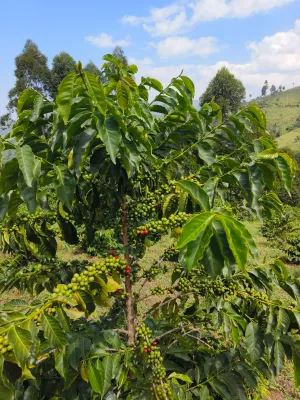
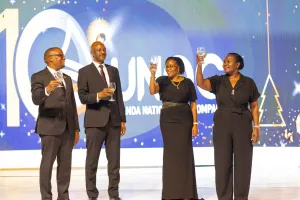
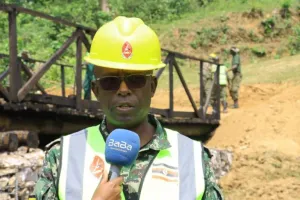




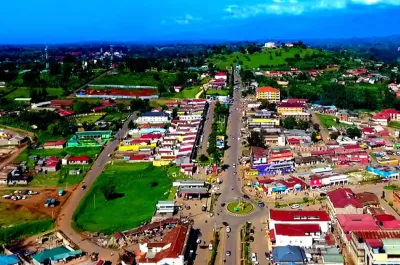




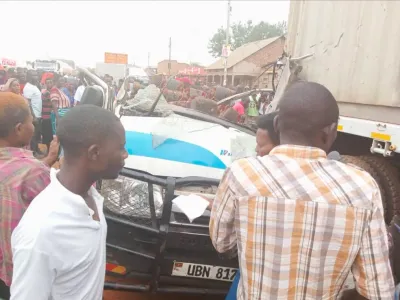
Joan Ainabyona
Leave a Comment
Your email address will not be published.